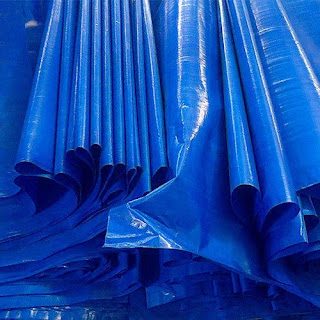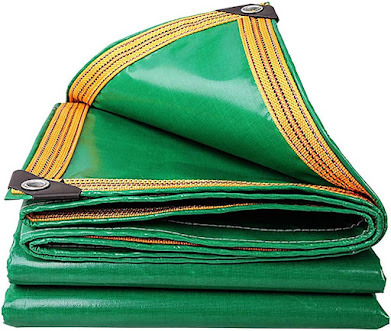5 Different Types of Cotton Tarpaulin Materials You Should Know
Large Tarpaulins, often referred to just as canvases, are flexible and strong materials utilized in different applications, from covering merchandise during transport to safeguarding outside spaces from the components. While numerous tarpaulins are produced using manufactured materials like polyethylene or vinyl, cotton tarpaulin materials have been well-known for quite a long time because of their normal properties and eco-benevolence. In this article, we'll investigate five different types of cotton tarpaulin materials you should know, each with its exceptional qualities and applications.
Canvas Tarpaulins
Canvas coverings are among the most notable and generally utilized cotton tarpaulin materials. They are commonly produced using a substantial cotton texture that is treated to improve its strength and water obstruction. Canvas coverings are exceptionally flexible and track down applications in a great many ventures.
Key Features:
Sturdiness: Canvas tarpaulins are known for their solidarity and life span, making them appropriate for substantial applications.
Breathability: These canvases permit air to go through, forestalling buildup and advancing the safeguarding of the covered things.
Water Obstruction: While not completely waterproof, canvas canvases are treated to oppose dampness and are often utilized for covering development materials, hardware, and outside gear.
Applications:
Canvas coverings are usually utilized in development, horticulture, and as open-air covers for boats, vehicles, and furniture. They additionally act as drop cloths for painting and as defensive covers for hardware and apparatus.
Duck Cloth Tarpaulins
Duck cloth is a firmly related material to canvas, yet it is woven all the more firmly, making it much more sturdy and reasonable for specific applications where additional strength is required. Duck cloth coverings are often utilized in circumstances where the most extreme assurance is required.
Key Features:
Additional Solidness: Duck cloth is woven more firmly than standard canvas, making it especially sturdy and resistant to scraped areas.
Flexibility: Duck cloth coverings are great for substantial purposes and can endure unforgiving ecological circumstances.
Water Opposition: These coverings are treated to oppose water and give fantastic assurance against the components.
Applications:
Duck cloth canvases are ordinarily utilized in the shipping and transportation industry to cover and safeguard freight. They are likewise appropriate for building locales, as well as covering open-air furniture, gear, and hardware.
Ripstop Cotton Tarpaulins
Ripstop cotton coverings are intended to be incredibly tear-resistant. They are woven in a manner that consolidates building up strings at standard stretches, keeping little tears from venturing into bigger ones. This kind of covering is especially valuable in applications where keeping up with the trustworthiness of the texture is urgent.
Key Features:
Tear Obstruction: The ripstop configuration keeps little tears from spreading, guaranteeing the covering's life span.
Strength: Ripstop cotton canvases offer a decent harmony between solidness and weight, making them flexible and simple to deal with.
Water Opposition: These coverings are treated for water repellency, yet they may not be altogether waterproof.
Applications:
Ripstop cotton tarpaulins canvas are ordinarily utilized in setting up camp and outside sporting exercises, as they are lightweight and tough. They can likewise be utilized as covers for gear, vehicles, and outside stockpiling.
Treated cotton tarpaulins are customary cotton canvases that have been treated with different coatings or synthetic substances to improve their protection from water and other ecological variables. This treatment cycle essentially works on their exhibition in antagonistic circumstances.
Key Features:
Improved Water Opposition: The treatment applied to these canvases makes them more water-resistant than untreated cotton.
Shape and Buildup Opposition: Treated cotton canvases are less vulnerable to form and mold development, making them appropriate for long-haul outside use.
Flexibility: They offer harmony between toughness and moderateness.
Applications:
Treated cotton canvases are broadly utilized as covers for open-air gear, as transitory roofing during development, and in farming settings to shield yields and hardware from the components.
Frame-Resistant Cotton Tarpaulins
In specific businesses, especially those including welding or flame-related work, fire well-being is foremost. Flame-resistant cotton tarpaulins are uncommonly intended to endure openness to flames and high temperatures, guaranteeing specialist security and the insurance of important resources.
Key Features:
me Obstruction: These coverings are treated with flame-retardant synthetics, making them appropriate for use in conditions where fire wellbeing is vital.
Strong: While flame-resistant, these coverings are as yet powerful and dependable.
Flexibility: They can be utilized in development, welding, and modern settings where fire dangers exist.
Applications:
Flame-resistant cotton coverings are fundamental in ventures like development, welding, and assembling, where the gamble of fire or openness to high temperatures is available. They are likewise utilized for transitory haven during crisis circumstances where fire security is a worry.
All in all, cotton tarpaulin materials offer a scope of choices to take special care of different requirements and inclinations. From standard canvas and duck cloth coverings to specific ripstop, treated, and flame-resistant variations, there is a cotton canvas for basically every application.
While picking the right cotton tarpaulin for your particular requirements, consider factors like strength, water opposition, tear obstruction, and flame protection to guarantee you get the best assurance and execution for your expected use. Whether it's for development, transportation, open-air stockpiling, or modern applications, cotton canvases stay a solid and eco-accommodating decision.




Comments
Post a Comment